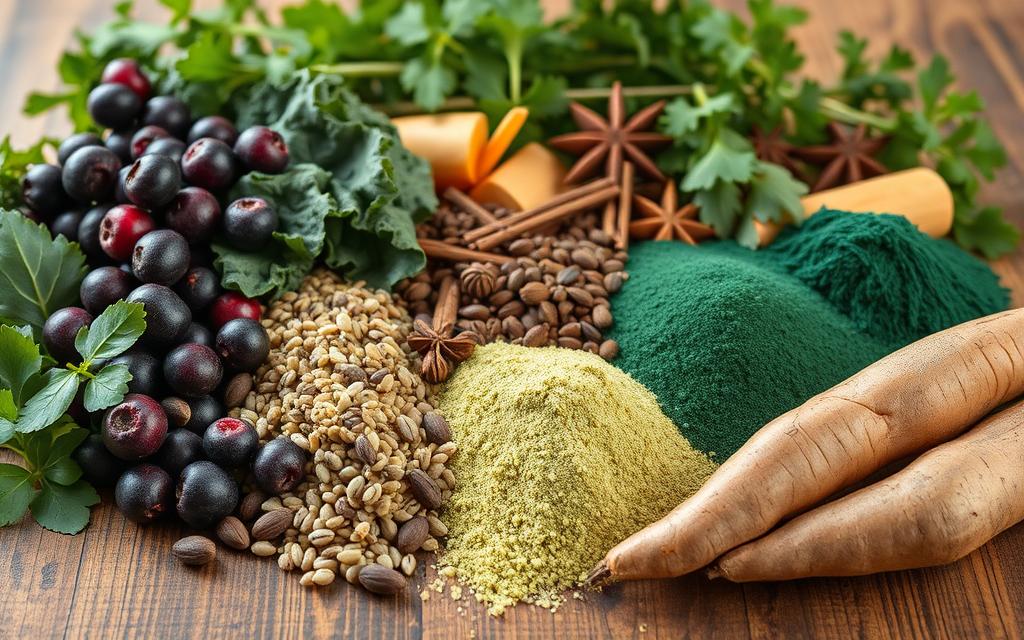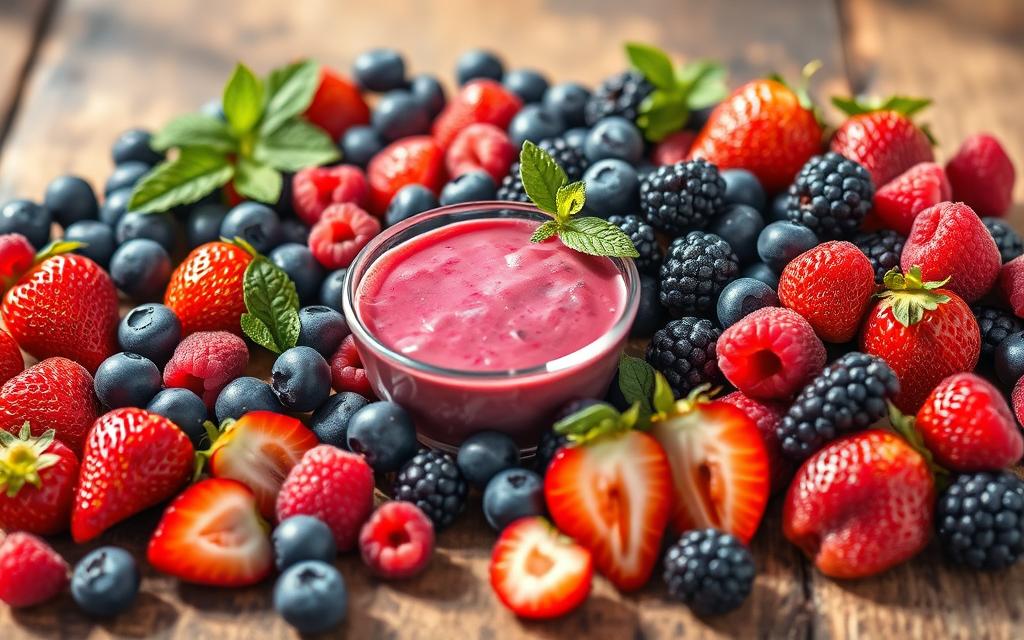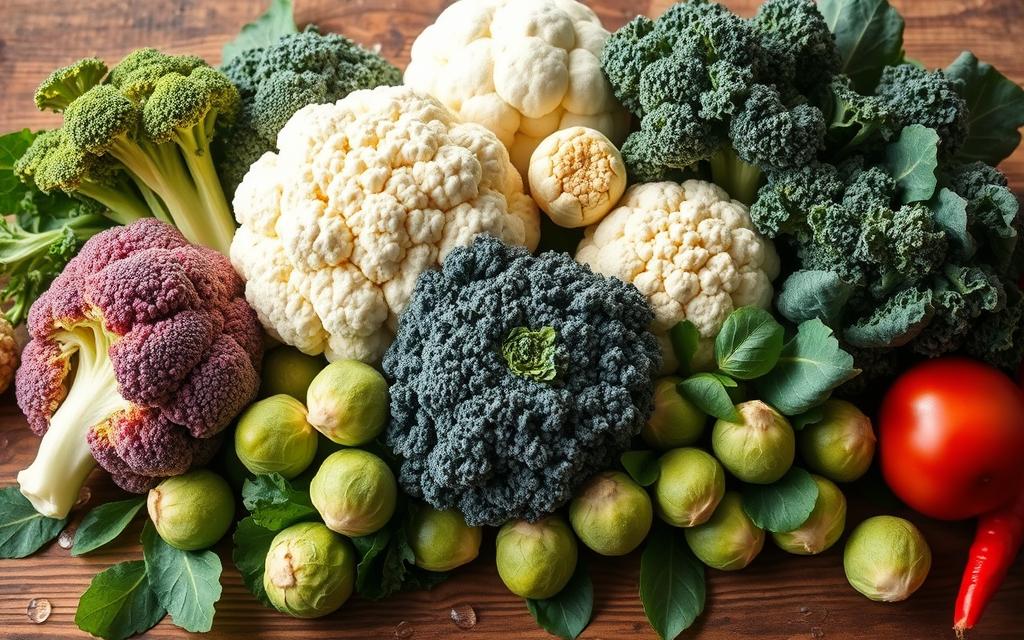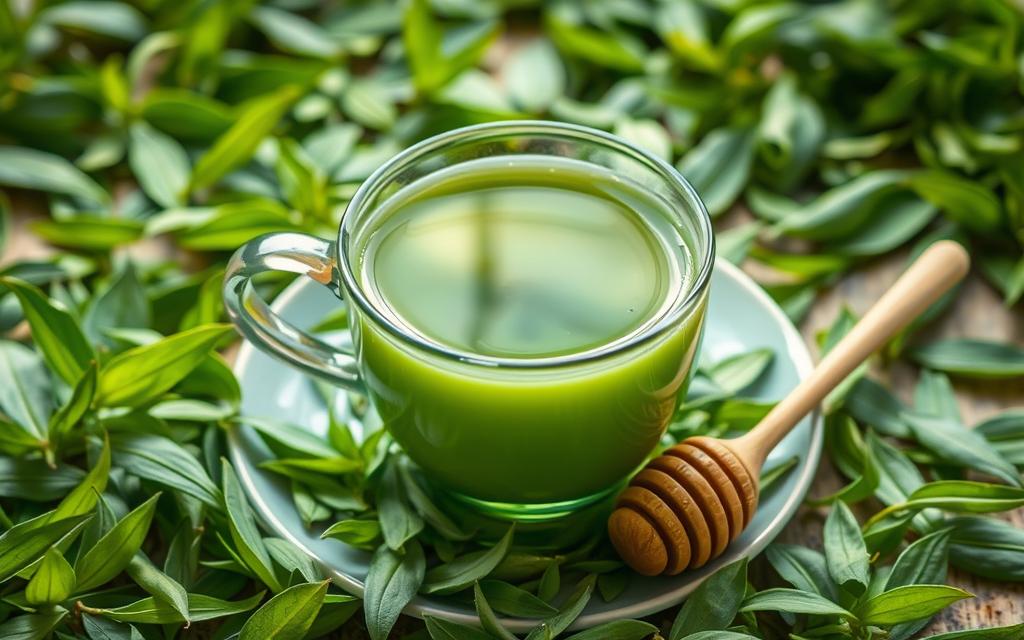As we start a new year, we think about our health and how to feel better. Imagine waking up full of energy and excitement, knowing our choices make our bodies strong. Superfoods are at the heart of this, offering vitamins, minerals, and antioxidants to help us thrive.
In 2024, we’re learning how these foods boost our immune system and fight chronic diseases. A survey of 564 dietitians shows fermented foods are key for gut health this year. The Mediterranean diet is also a big hit, seen as the best for wellness by U.S. News & World Report1.
This year, let’s look at the top superfoods to add to our meals. They can make our lives more vibrant and healthy.
Key Takeaways
- Superfoods are nutrient-dense foods that offer various health benefits.
- Fermented foods have been identified as key for gut health in 2024.
- The Mediterranean diet is recognized as the best for overall health.
- Incorporating superfoods can help boost energy and vitality.
- Understanding the benefits of various superfoods can guide healthier eating choices.
- This year, we focus on practical ways to include superfoods in our meals.
- Superfoods differ widely, appealing to a diverse range of dietary preferences.
What are Superfoods and Why are They Important?
Superfoods are foods packed with nutrients and health benefits. The term “superfood” is not officially defined but has become popular in marketing. It has shaped food trends in recent years2. These foods are important because they can improve our health and fight chronic diseases.
Dark green leafy vegetables (DGLVs) can lower the risk of heart disease and type 2 diabetes2.
Eating a variety of nutrient-rich foods boosts our immunity and energy. Berries, for example, can reduce the risk of heart disease, cancer, and inflammation because of their antioxidants2. Many people believe that what they eat affects their health, with over 75% of individuals agreeing3.
Using foods to prevent ailments like obesity and diabetes is a growing trend. Nearly 80% of consumers are involved in this nutritional movement3.
Superfoods come in many colors, showing their high levels of vitamins, minerals, and antioxidants. Adding these foods to our meals supports our health affordably. It makes healthy eating accessible to everyone.
The Role of Nutrient-Dense Foods in Our Diet
Nutrient-dense foods are key for a healthy diet. They give us important vitamins and minerals with few calories. Eating these foods helps us stay healthy and manage our weight.
Superfoods, with their high nutritional value, play a big role in our diet. They help prevent diseases like heart disease and cancer4.
Adding a variety of nutrient-dense foods to our diet is beneficial. Leafy greens like kale are packed with nutrients. One cup of kale gives over 680% of vitamin K, with just 9 calories5. Eating fruits and vegetables regularly also lowers the risk of health problems6.
Foods like wild Atlantic salmon are full of omega-3 fatty acids and protein. They greatly improve our nutrition5. Eating at least 400 grams of fruits and vegetables daily helps prevent diseases6. Including them in our meals ensures we get the nutrients we need and enjoy their health benefits.
Health Benefits of Incorporating Superfoods
Adding superfoods to our meals can greatly improve our health. These foods are packed with nutrients like vitamins, minerals, and antioxidants. They also have fiber7. Eating them regularly can help fight inflammation, boost our immune system, and lower the risk of chronic diseases like heart disease and diabetes8.
Blueberries are famous for their antioxidants, which help keep our hearts healthy and our bones strong. They also support our skin7. Kale is another superfood, full of vitamin K, which is key for bone health and preventing blood clots7. Not getting enough vitamin K can cause health problems, making these foods even more important.
Quinoa is a complete protein, meaning it has all the amino acids we need for growth and repair7. It’s essential to eat a variety of foods to get all the nutrients our bodies need7. Chia seeds are high in fiber, which helps control cholesterol and supports heart health8.
Avocados are good for our hearts because they contain healthy fats8. The American Heart Association says berries can lower heart attack risk in women8. Beets, with their anti-inflammatory compounds, may help fight Type 2 diabetes and heart disease8.
Adding superfoods to our daily meals is a simple way to boost our health. It’s important to try different types of superfoods to find what works best for us.
Top Superfoods to Consider
Adding top superfoods to our diet boosts our health and well-being. These foods include fruits, vegetables, nuts, and grains. They offer great benefits. Studies say we need about 30 grams of fiber daily for health9.
One way to get enough fiber is to eat two-thirds of our meals with plant foods9.
Here’s a list of superfoods that are easy to add to our diet:
| Superfood | Key Nutritional Benefits |
|---|---|
| Blueberries | High in antioxidants and linked to reduced heart attack risk10. |
| Kale | Rich in carotenoids and vitamins A, C, and K; help protect against some cancers10. |
| Quinoa | A complete protein source providing all nine essential amino acids11. |
| Salmon | Packed with omega-3 fatty acids beneficial for heart health10. |
| Greek Yogurt | High in protein, supports gut health11. |
| Garlic | May help lower cholesterol and reduce cancer risk10. |
| Dark Chocolate | Contains flavonoids, potentially preventing heart disease10. |
To stay healthy, eat at least three cups of dark leafy greens a week11. Following a superfood list helps us make smart food choices. This ensures we get the most from these nutrient-rich foods.

Dark Leafy Greens: The Powerhouse of Nutrients
Dark leafy greens like kale, spinach, and collard greens are packed with nutrients. They are a key part of a healthy diet. These greens give us 10% or more of 17 nutrients in just 100 calories, as the CDC says12. They are low in calories but high in fiber, helping us stay full and manage our weight13.
Varieties of Dark Leafy Greens
Each type of dark leafy green has its own health benefits. Kale, for example, is rich in vitamin K and antioxidants like beta-carotene and lutein. These help protect our immune system12. Romaine lettuce has more vitamin A than iceberg lettuce, making it a better choice for our meals12. Collard greens are full of fiber, calcium, and vitamin C, while arugula is high in folate and potassium12.
How to Include Dark Leafy Greens in Your Meals
It’s easy to add dark leafy greens to our meals. We can toss them into salads, blend them into smoothies, or add them to soups. Here are some ways to do it:
- Adding spinach or kale to smoothies for a nutrient-dense breakfast.
- Using arugula as a base for salads alongside various toppings.
- Stir-frying bok choy or collard greens with garlic for a savory side dish.
- Mixing leafy greens into scrambled eggs or omelets for added flavor and nutrients.
By making dark leafy greens a regular part of our diet, we can boost our health. They help reduce oxidative stress and improve brain function13. Dark leafy greens make our meals more varied and nutritious.
Berries: Antioxidant-Rich Delights
Berries add sweetness to our meals and offer great health benefits. They are full of vitamins, minerals, and fiber. Blueberries, strawberries, and raspberries fight inflammation and reduce disease risk14. Adding different berries to our meals boosts nutrition and adds flavor.
Types of Berries to Add to Your Diet
Choosing various berries can improve our health in many ways. Here are some great choices:
- Blueberries: Have 84 calories per cup and 16% of Vitamin C daily value14.
- Strawberries: With 46 calories per cup, they give 94% of Vitamin C daily value14.
- Raspberries: Only 64 calories per cup, they offer 36% of Vitamin C and manganese daily value14.
- Cranberries: Low in calories but rich in antioxidants, with 46 calories per cup14.
- Bilberries: These small berries have 48 calories and 49% of Vitamin C daily value14.
Berry Smoothies: A Quick and Tasty Recipe
Making a berry smoothie is a simple way to enjoy berries. Here’s a quick recipe:
- Put 1 cup of mixed berries (blueberries, strawberries, and raspberries) in a blender.
- Add 1 cup of Greek yogurt for creaminess and protein.
- Use 1 cup of milk (dairy or non-dairy) for the right consistency.
- Blend until smooth and enjoy!
This smoothie is not only tasty but also packed with antioxidants and nutrients15.

Avocados: Healthy Fats for Heart Health
Looking for ways to improve heart health through diet? Avocados are a great choice. They are full of monounsaturated fats, which can lower bad LDL cholesterol and increase good HDL cholesterol16. Eating at least two avocados a week can lower heart disease risk by 16% compared to those who rarely eat them17.
Avocados have about 322 calories in a 7-ounce serving. They offer around 30 grams of healthy fats and 14 grams of fiber18.
Avocados are packed with 22 essential nutrients, including Vitamin K, Vitamin E, and potassium16. They’re versatile, making them great for salads, spreads, or smoothies. This makes it easy to eat them regularly, which is important since avocado consumption has risen a lot in the U.S. over the past 20 years17.
| Nutritional Component | Amount per Serving (Half Avocado) |
|---|---|
| Calories | 161 |
| Healthy Fats | 15 g |
| Monounsaturated Fats | 5 g |
| Polyunsaturated Fats | 1 g |
| Fiber | 7 g |
| Vitamin C | 22% DV |
| Vitamin E | 28% DV |
| Vitamin K | 35% DV |
Eating avocados regularly can add flavor and texture to meals. It also helps a lot with heart health. By choosing healthier fats over saturated and trans fats, we can improve our heart health16. Avocados are a key part of a healthy diet, thanks to their nutrients and heart benefits.
Cruciferous Vegetables: Nature’s Cancer Fighters
Cruciferous veggies like broccoli, Brussels sprouts, and cauliflower are packed with benefits. They contain glucosinolates that may fight cancer types such as breast, pancreatic, and colon cancer19. Adding these foods to our diet can boost our health and help prevent cancer.
One cup of broccoli gives us 5 grams of fiber, helping us meet our daily fiber goal19. Broccoli also has 80 milligrams of Vitamin C per cup, and Brussels sprouts have 75 milligrams19. These vitamins strengthen our immune system and help prevent cancer by supporting cell health.
Half a cup of collard greens has 530 micrograms of Vitamin K, far exceeding the daily recommended amount19. Cruciferous veggies are also rich in folate, crucial for DNA repair. Half a cup of cooked broccoli has 84 micrograms of folate, close to the FDA’s daily adult recommendation19. The American Cancer Society suggests a diet rich in plants, making these veggies a key part of our meals20.

The health perks of cruciferous veggies are immense. We should make them a staple in our diet to fight cancer and enjoy their nutritional benefits.
Greek Yogurt: A Probiotic Powerhouse
Greek yogurt is a great choice for our diet because of its high protein and probiotics. It has about 20 grams of protein in 7 ounces, making it a filling and healthy snack. This can help us eat fewer calories later in the day21.
The live cultures in Greek yogurt are key for a healthy gut. They help our immune system work better22.
Adding Greek yogurt to our meals is easy and fun. We can mix it into smoothies, use it in dressings, or enjoy it with fruits and honey. Eating it regularly can improve our digestion and help with issues like irritable bowel syndrome21. It also helps with diarrhea caused by antibiotics22.
Greek yogurt is packed with nutrients that boost our gut and immune health. It has a lot of calcium, giving us almost half of what we need in one cup. This is good for our bones and overall health21. By eating Greek yogurt, we get to enjoy its taste while supporting our well-being.
Green Tea: The Antioxidant Beverage
Green tea is packed with antioxidants, like EGCG, which is great for our heart and reduces inflammation. Drinking it regularly can help prevent type 2 diabetes and some cancers. But, some benefits need more research23.

How to Brew Perfect Green Tea
To get the most out of green tea, follow these steps:
- Use fresh, cold water and heat it to 175°F (80°C) for the best taste.
- Add 1 to 2 teaspoons of loose leaf green tea or one tea bag per cup.
- Steep for 2 to 3 minutes. Steeping too long can make it bitter.
- Drink it plain or with lemon for extra vitamin C.
Drinking green tea daily can lead to great benefits. For example, four or more cups a day can lower the risk of belly fat, mainly in women24. Enjoying three to five cups a day can also boost our health. Some studies suggest it might even help us live longer24.
Mushrooms: Versatile and Nutrient-Rich
Mushrooms are a great addition to our diets. They are low in calories and have no cholesterol or sodium25. They are packed with B vitamins, vitamin D, antioxidants, potassium, fiber, and copper26. Eating mushrooms can help lower heart disease, cancer, and other chronic illnesses risks25
Mushrooms have been a part of human diets for over 19,000 years26. Their popularity has grown with plant-based diets, making them a good meat substitute26. You can find many types like Button, Cremini, Portobello, Porcini, and Shiitake25.
| Mushroom Type | Production Percentage |
|---|---|
| Agaricus bisporus (white mushroom) | 22% |
| Lentinus edodes (shiitake) | 19% |
| Pleurotus spp. (oyster mushroom) | 15% |
| Flammulina velutipes (enoki mushroom) | 11% |
To keep mushrooms fresh, store them in a paper bag or breathable container in the fridge. They should be eaten within a few days to avoid spoilage25. Mushrooms are good for our gut health, thanks to their prebiotic activity27. Their nutritional value and versatility make them essential for healthier eating.
Olive Oil: The Heart-Healthy Fat
Olive oil is key in the Mediterranean diet, offering healthy fats for well-being. One tablespoon has about 119 calories, with 73% from monounsaturated fats like oleic acid. These fats are good for the heart28.
Drinking olive oil regularly can lower blood pressure and improve blood vessel function. It also gives us important vitamins, like 13% of Vitamin E and 7% of Vitamin K per tablespoon28.
Olive oil’s benefits go beyond just numbers. Countries following the Mediterranean diet, with lots of olive oil, have fewer heart disease deaths than the U.S29. This diet, rich in unsaturated fats, lowers bad cholesterol and heart disease risk29.
Studies show olive oil fights inflammation and lowers disease risks, including heart disease, cancer, and Alzheimer’s28.
Adding olive oil to our meals adds flavor and nutrition. It’s a simple way to boost our health while enjoying tasty food.

Nuts: Snack Smart with Superfoods
Nuts are a top choice for healthy snacks, full of nutrients that boost our well-being. They’re rich in healthy fats, like monounsaturated fats, which lower bad cholesterol and heart disease risk30. Adding nuts like almonds, walnuts, and pistachios to our diet boosts our nutrient intake. They’re packed with vitamins and minerals like vitamin E, magnesium, and selenium, vital for our health31.
Nuts are good for our hearts and have anti-inflammatory effects, helping those with inflammatory diseases31. They help control blood sugar, great for people with diabetes or metabolic issues. The fiber in nuts also makes us feel full, helping with weight management and reducing calories31. Adding nuts to breakfast can start our day right and prevent cravings later.
Even though nuts are high in calories, watching portion sizes is crucial for their health benefits without overeating30. Aim for 30 grams most days, making it simple to add them to our diet. With their diverse flavors, nuts are versatile in cooking, from snacks to recipes, adding superfood benefits to our meals30.
Conclusion
Adding superfoods to our diet brings many health benefits. It can greatly improve our overall health and help prevent diseases. The term “superfood” has almost 10 million search results online, showing its popularity and interest in food and health32.
Superfoods are fruits and veggies that offer more health benefits than regular foods. This makes them great for our health.
For example, blueberries are full of anthocyanins. These have been shown to stop cancer cells from growing and may prevent memory loss32. With 136 foods labeled as superfoods, it’s important to try them out and mix up our meals33.
Trying different superfoods in our cooking not only increases our nutrition. It also introduces new flavors and dishes to our meals. This exploration can lead to better health and lasting wellness.
FAQ
What exactly are superfoods?
Superfoods are foods that are very good for us. They are full of vitamins, minerals, and antioxidants. These nutrients help boost our immune system and prevent diseases.
How can superfoods improve our health?
Eating superfoods can make our immune system stronger. It also helps reduce inflammation and lower the risk of diseases like heart disease and diabetes. Plus, they fight oxidative stress and protect our cells.
Are superfoods expensive?
No, many superfoods are affordable. You can find dark leafy greens, berries, and nuts at good prices. They’re available in most grocery stores or local markets.
Can I include superfoods in my smoothies?
Yes, you can! Spinach, berries, and Greek yogurt are great in smoothies. They add flavor and nutrients to your drinks.
What are some easy ways to incorporate superfoods into our meals?
There are many ways to add superfoods to your meals. Try adding dark leafy greens to salads, berries to smoothies, or olive oil to dishes. It’s fun to try new recipes.
Are there any superfood supplements available?
Yes, there are many superfood supplements. You can find powders made from spirulina, acai, and chlorella. They’re good for boosting your nutrient intake if you can’t eat enough whole foods.
What is the best way to store superfoods to maintain their benefits?
To keep superfoods healthy, store them right. Keep berries and leafy greens in the fridge. Store nuts and seeds in a cool, dark place in airtight containers. This keeps them fresh longer.
